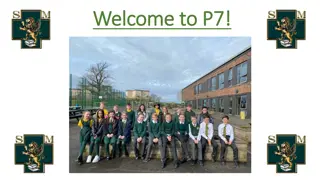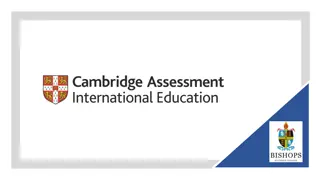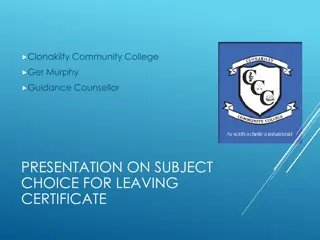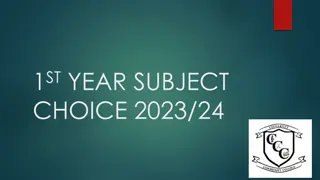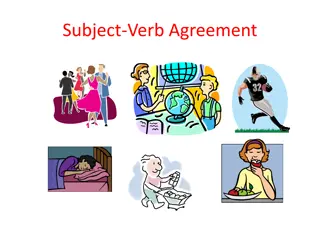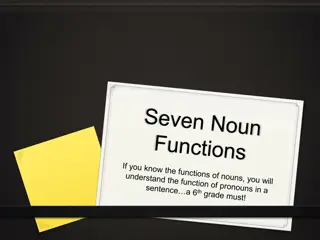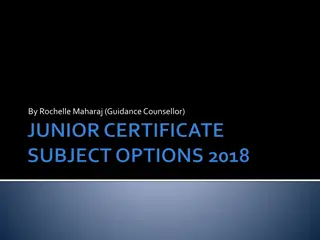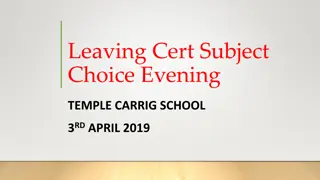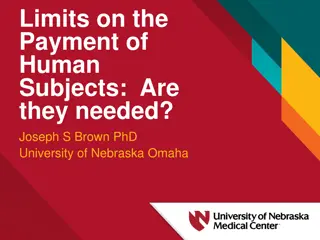English Education Students' Responses to Classroom Activities for Theory-Based Subjects
Explore how classroom activities play a crucial role in teaching theory-based subjects to English education students. Discover the challenges faced during the transition and the solutions provided through effective teaching goals and activities. Delve into the literature review on classroom activities, types, and their impact on students' learning outcomes.
Download Presentation

Please find below an Image/Link to download the presentation.
The content on the website is provided AS IS for your information and personal use only. It may not be sold, licensed, or shared on other websites without obtaining consent from the author. Download presentation by click this link. If you encounter any issues during the download, it is possible that the publisher has removed the file from their server.
E N D
Presentation Transcript
ENGLISH EDUCATION STUDENTS RESPONSES TOWARD CLASSROOM ACTIVITIES FOR THEORY-BASED SUBJECTS Evi Puspitasari Universitas muhammadiyah yogyakarta
1. INTRODUCTION WHY CLASSROOM ACTIVITIES? Teachers action and decision to reach the goal of teaching (Richards & Lockhart, 2005)
THEORY BASED SUBJECTS = CONTENT BASED INSTRUCTION WHY I AM INTERESTED IN THIS TOPIC?
Recent curriculum in EED at one of universities in Indonesia Academic Year Types of Instruction Skill based Subjects Junior (semester 1 & 2) Basic Reading and Writing, dll Reading & Writing for Career Dev, Principles of Teaching and Learning, Language Learning and Acquisition transition Sophomore (semester 3 & 4) Theory based Teaching English as a Foreign Language Issues in Lang. TL Senior (semester 5 & 6) Research based Curriculum Design, Instructional Design Language Research, Research Methodology
Problems in the transition Striving with the language Struggling to understand the content S O L U T I O N TEACHING GOAL Classroom activities
QUESTIONS 1. What classroom activities are implemented for the theory based subjects? 2. What are the students responses toward the activities?
LITERATURE REVIEW DEFINITION OF CLASSROOM ACTIVITIES purposeful classroom procedure that involves learners doing something that relates to the goals of the course Richards and Lockhart (2005) TYPES OF CLASSROOM ACTIVITIES Based on Richards and Lockhart (2005) (memorization, comprehension, application activities, strategy activities, affective activities, feedback activities, assessment activities) EFFECTIVE CLASSROOM ACTIVITIES developing aptitude and motivation, enhancing fluency and accuracy, and promoting the students to use the target language for spontaneous and prepared communication (Harris & Duibhir, 2011)
CONTENT BASED INSTRUCTION Characteristics of CBI based on Brinton, Snow, & Wesche (2003) The activities of the language class are Specific to the subject matter being taught 1. Geared to stimulate Ss to think and learn through the use of target language 2. Using authentic materials which need Ss high level thinking skills 3. Providing a forum in which Ss can respond orally (discussion) 4. Producing academic writing that follows from listening and reading 5. Exposed Ss to study skills and learn a variety of language skills which prepare them for the range od academic tasks they will encounter 6.
WHAT I DID TO ANSWER THE QUESTIONS Interviewed 4 students who enrolled 2 theory based subjects Aya, Budi, Citra, and Devi. They were communicative and cooperative, bright and outstanding students in the classes They enrolled these theory-based subjects >> Principles of teaching and learning (4 credits) L1, L2 >> Language Learning and Acquisition (4 credits) L3, L4
FINDINGS Q1:What classroom activities are implemented for the theory based subjects? The result showed that there were various activities they did in the theory based classes The fourth participants (Aya, Budi, Citra, and Devi) stated classroom activities they did in the theory based subjects were: Presentation, Group Teaching, Weekly Essay, Lecturing, Discussion, Self-reflection, Final Project
Q2: What are students responses toward the activities? They responded that most of the activities helped them comprehend the materials. However some say that there were some activities needed to be revised to be more effective Activities Implementation Responses Reasons Problems 1.PRE- SENTATION (30 minutes) - 3 or 4 ss - Present an assigned chapter - QA - Feedback about content, language, paralinguistic - Feedback about slides and teaching media Positive (Aya, Budi, Citra, and Devi) They are conditioned to read Presenters: preparation to deliver the materials Audience: be participative (Aya, Budi) and be anticipative (Aya) Not all students read Not all students present well
Activities Implementation Responses Reasons Problems They loved the feedback about their performance (content, language, paralinguistic) not the teaching media The feedback could help them improve their presentation skill They lacked of interest to get feedback about their slides They needed more teacher s feedback about the content to justify the material they presented
Activities 2. GROUP TEACHING ( 90 minutes) Implementation Responses - 3 or 4 ss - Group consultation - Teaching their classmates - Questions from the teacher - Discussion in the middle of presentation Reasons - Ss can learn how to teach (Devi and Citra) Problems - In the middle of the teaching session, the teacher asked aud. questions toward the topic - Presenters felt distracted and lost focus. Positive
Activities Implementation Responses Reasons Problems 3. ESSAY (30 minutes) - Weekly - Answering 2 or 3 questions on essay - Feedback from the teacher on their writing (content, language, mechanics) - Discussion Positive They were set to read and it was good for their comprehension. (Aya, Citra, Devi) Some students did not read, they relied on their friends presentation (Budi) (Aya, Citra, Devi) It was good to improve their writing (Citra) They preferred the quiz being put on the last session after group discussion and lecture from the teacher (Citra, Devi) They loved the feedback. It was good for their writing improvement (Citra, Devi) Every four meeting - Multiple choices Less positive (Aya, Budi) They did not feel comfortable with multiple choice questions. One of them said it was not for higher education ss. (Budi) MCQ was not able to check SS comprehension The other it limited their thought to express what they knew (Aya)
Activities 4. LECTURING (30 minutes) Implementation During 30 minutes, the teacher gave lecture to create mutual understanding on the concept Responses Positive (Aya, Budi, Citra, Devi) Reasons It helped them to comprehend the materials. (Aya, Budi, Citra, Devi) Problems 30 minute lecturing is not enough for them to discuss the assigned chapter. They needed more time for this part (Citra, Devi) Language used by the teacher was casual and simple. It made them at ease to understand the materials. (Citra, Devi) The student counted on this session much. He seldom read the book himself then (Budi) The teachers liked making a joke which would not make the lecture boring (Aya, Budi)
Activities Implementation Responses Reasons Problems 5. Discussion (30 minutes) GRAPHIC ORGANIZER and MIND MAP - Group 3 or 4 - Done before quiz - Summary on a graphic organizer or mind map Positive with suggestion It helped them prepare to join the weekly quiz (Citra, Devi) The teacher was not clear in limiting what they had to put in the graph/ mind map (Devi) Some people didn t not contribute much (Citra) (Citra, Devi) PROBLEM SOLVING - Without group setting - They can discuss with anyone to find the solution Positive but at some points needed to be revised (Devi) They could understand in what situation the concept learned applied (Devi) The teacher gave the case in the middle of presentation, it distracted the presenters (Devi) The teacher said there was no wrong and right answer. It made them confused to state their position (Devi)
Activities Implementation Responses Reasons Problems 6. Reflection SELF Individual work Ss did reflection on what they got by joining the class and told how they felt about the course. GROUP Individual work Ss reflected things happened in their group. Here, they revealed how they felt about working together with their members in a group. positive (Aya, Citra, Devi) They could write something unrelated to the chapters learned. (Aya, Citra, Devi) It was done only at the end of the semester. At some points, they forgot what they passed. (Citra) Positive (Citra, Devi) They could maintain their teamwork because they were afraid of getting a bad comment from their team mate (Citra, Devi)
Activities Implementation Responses Reasons Problems 7. Final Project a. Observation report - working individually observing the way people acquire and learn a new language positive They could relate the concepts to things happening in their surrounding (Citra, Devi) - b. Mini research - working individually or group consultation 15 minutes before the class finished They responded positively They could familiarize themselves with research earlier (Aya, Citra, Devi) The consultation was done 15 minutes before the class finished. Some students was in a hurry to leave the class and they lost their focus to do it (Aya, Budi) - (Aya, Budi, Citra Devi)
DISCUSSION Those activities can be put on types of activities that Richards and Lockhart (2005) generated. 1. Comprehension activities Presentation, Group Teaching, Weekly Essay, Lecturing 2. Strategy activities Discussion 3. Feedback activities Post activity for Weekly Essay and Presentation 4. Affective activities Self reflection 5. Assessment activities Final project
Students responses toward the activities Based on the responses, it can be known that the activities are successfully able to improve the students fluency in writing and speaking. From the teachers feedback on their essay and presentation, the activities also possibly improve their accuracy. It is in line with Harris & Duibhir (2011) In addition, the activities help the students familiarize themselves with things that they are going to have next year (research). Those are supported by Brinton, Snow, & Wesche (2003). Their suggestion for the activities deal with teachers role (giving clear command and instruction) and time setting matters, the teachers should manage the time by figuring out the students convenience. It is in parallel with Nunan (2004)
CONCLUSION In conclusion, to facilitate the students comprehension in learning theory based subjects, the teachers should design activities that can motivate them to improve both the target language and the skills on the subjects. The activities should provide the students sufficient opportunity to explore and explain new things that they know without limiting their interpretation to the new in line with Harris & Duibhir (2011) in line with Harris & Duibhir (2011) in line with Harris & Duibhir (2011) knowledge. Activities suggested by this research are presentation, group teaching, quiz, lecturing, discussion, self-reflection, and final project. The activities would be better completed with feedback on students work (both language and concept learned) Even though the activities above need minor revision on teacher role and time setting, most of them have positive responses from the students.
REFERENCES Brinton, D., Snow, M.A., & Wesche, M.B.2003. Content-based second language instruction. Boston: Heinle and Heinle Publishers. Harris, J. & Duibhir, P.O. 2011. Effective language teaching: a synthesis of Research. Dublin: National council for curriculum and assessment. Nunan, D. 2004. Task-based language teaching. New York: Cambridge University Press. Richards, J. C & Lockhart, C. 2005. Reflective teaching in second language classroom. New York: Cambridge University Press.

 undefined
undefined





